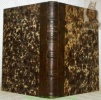-
Type
Book (19849)
Magazine (13)
Manuscript (4)
Maps (1)
Photographs (4)
-
Latest
Last 24h (1)
Last month (23)
Last week (6)
-
Language
English (43)
French (19817)
German (2)
Japanese (1)
Latin (1)
Polish (2)
Portuguese (1)
Russian (1)
Spanish (1)
Swedish (2)
-
Century
16th (6)
17th (37)
18th (302)
19th (3729)
20th (11867)
21st (1523)
-
Countries
Belgium (360)
Brazil (1)
Côte d'Ivoire (13)
Denmark (1352)
France (17989)
Switzerland (156)
-
Syndicate
ILAB (17277)
NVVA (26)
SLACES (26)
SLAM (15899)
SNCAO (12)
Development of Minkowski geometry of numbers -- EDITION ORIGINALE -- BEL EXEMPLAIRE
N.Y., MacMillan, 1939, un volume in 8 relié en pleine toile éditeur, 24pp., (1), 839pp.
---- EDITION ORIGINALE ---- BEL EXEMPLAIRE ---- Cajori pp. 371 & 372**5827/P5DE
Elliptic Integrals.
New York, John Wiley & Sons, 1917. Orig. full cloth. 104 pages, including tables and index.
First Edition First Thousand. Mathematical Monographs, No. 18.
Lectures on the calculus of variation (The Weierstrassian theory). Bulletin of mathematics n° 1 -- EDITION ORIGINALE -- PRESENTATION COPY TO EMILE PICARD -- BEL EXEMPLAIRE
Cincinnati, Cincinnati University press, 1904, un fort volume grand in 4 relié en demi-chagrin noir, dos et plats ornés de filets dorés (reliure de l'époque), 16pp., 292pp., (1)
---- EDITION ORIGINALE ---- Exemplaire SUR GRAND PAPIER ayant appartenu à Emile PICARD dont le nom est inscrit en lettres dorées sur le premier plat de couverture ---- ENVOI DE HARRIS HANCOCK à Emile PICARD ainsi libellé : "To prof E. Picard with the kind remembrances and best wishes - signé Harris HANCOK" ---- BEL EXEMPLAIRE ---- "Prominent researches on the calculus of variations are due to J.G. Darboux, E. Goursat, E. Zermelo, H.A. Schwarz, H. Hahn and to the american H. HANCOCK...". (Cajori p. 372)**25710/2571/N1
THEORIE DES PROBABILITES ET QUELQUES APPLICATIONS / Collection d'ouvrages de mathématiques a l'usage des physiciens .
MASSON ET CIE. 1965. In-4. Broché. Bon état, Couv. convenable, Dos satisfaisant, Intérieur frais. VII + 457 pages.. . . . Classification Dewey : 510-Mathématiques
Classification Dewey : 510-Mathématiques
Maths 2de repères
Hachette éducation. Non daté. In-4. Broché. Bon état, Couv. convenable, Dos satisfaisant, Intérieur frais. 368 pages augmentées de nombreux schémas en couleurs et en noir et blanc dans le texte. Etiquette collée sur le premier plat.. . . . Classification Dewey : 372.7-Livre scolaire : mathématiques
Classification Dewey : 372.7-Livre scolaire : mathématiques
Simple Survey Methods and Theory. 2 vols. (1. Methods and Applications. 2. Theory).
N.Y., Wiley & Sons, (1953). 2 orig. full cloth. XXII,638XIII,332 pp.
First edition.
Introduction à la logistique
1939 Hermann et Cie éditeurs "collection ""actualités scientifiques et industrielles"", logique et théorie de la science" broché, 65p. Très bon état.
Traduit de l'allemand par H. Savonnet. Table : le calcul des propositons - méthode de déduction - structure des phrases - classification des mots - le calcul des fonctions - le calcul des classes - les paradoxes - systèmess axiomatique.
Phone number : 04 76 97 79 28
Logaritmisch-trigonometrisches Handbuch welches die gemeinen Logarithmen der natürlichen Zahlen von 1000 bis 10000, so wie auch die Logarithmen der trigonometrischen Functionen...Wohlfeilere Ausgabe.
Wien, Rohrmann u. Schweigard, 1833. Lex8vo. Cont. hcalf. Gilt back. Some wear to back. Stamp on titlepage. XVIII pp. and 175 unnumb. pp.
Henderson, Bibliotheca Tabularum Mathematicarum No. 132.
NOTIONS ELEMENTAIRES DE GEOMETRIE DESCRIPTIVE APPLIQUEE AU DESSIN
Dunod. 1939. In-8. Relié. Bon état, Couv. légèrement passée, Dos frotté, Intérieur bon état. 191 pages. Illustré de nombreuses figures géométriques en noir et blanc dans le texte, dont quelques unes dépliables.. . . . Classification Dewey : 372.7-Livre scolaire : mathématiques
5e édition revue. Bibliothèque de l'enseignement technique. Classification Dewey : 372.7-Livre scolaire : mathématiques
Notions Elémentaires de Géométrie Descriptive appliquée au dessin.
DUNOD & PINAT. 1910. In-12. Relié toilé. Bon état, Couv. convenable, Dos satisfaisant, Quelques rousseurs. 172 pages. Nombreux schémas en noir et blanc dans le texte. Quelques planches dépliantes de schémas en noir et blanc hors-texte.Tranches rouges. Relié pleine tile verte.. . . . Classification Dewey : 510-Mathématiques
Bibliothèque de l'Enseignement Technique. Représentation du point, de la droite et du plan. Représentation des polyèdres et des corps ronds. Sections Planes. Intersections de solides géométriques... Classification Dewey : 510-Mathématiques
Cours de mathématiques - 4. exercices et problèmes corrigés - Nouvelle édition refondue classes préparatoires au haut enseignement commercial (programmes 1984) premiers cycles de l'enseignement supérieur.
Belin. 1984. In-8. Broché. Etat d'usage, Couv. légèrement pliée, Dos satisfaisant, Intérieur frais. 384 pages.. . . . Classification Dewey : 372.7-Livre scolaire : mathématiques
Classification Dewey : 372.7-Livre scolaire : mathématiques
COURS DE MATHEMATIQUES, 1, ALGEBRE
Belin. 1986. In-4. Broché. Bon état, Couv. convenable, Dos satisfaisant, Intérieur frais. 224 pages.. . . . Classification Dewey : 372.7-Livre scolaire : mathématiques
Collection Dia. Cours et exercices. Prépas HEC / ESCAE. Classification Dewey : 372.7-Livre scolaire : mathématiques
Introduction a la théorie des graphes orientés - modèles structuraux.
Dunod. 1968. In-8. Relié. Etat d'usage, Couv. convenable, Dos satisfaisant, Intérieur frais. VIII+437 pages - nombreuses figures en noir et blanc dans le texte - tampon sur la page de titre et sur la page de garde - une étiquette collée et tampon sur le 1er contre plat - jaquette abîmée, déchirée, pliée.. Avec Jaquette. . . Classification Dewey : 510-Mathématiques
Traduit par A.Gibert. Classification Dewey : 510-Mathématiques
Orders of Infinity. The 'Infinitärcalcül' of Paul du Bois-Reymond.
Cambridge, University Press, 1910. Cont. hcloth. 88),62 pp. Name on halftitle (Erling Følner).
First edition. Hardy was the leading English pure mathematician at the time. This is his second work. (Cambridge Tracts in Mathematics and Mathematical Physics).
Inequalities.
Cambridge, 1934. orig. full cloth. Top of spine frayed. XII,314 pp. Internally fine and clean.
First edition.
A Treatise on the Theory of Functions.
London a. N.Y., Macmillan and Co., 1893. Orig. full green cloth, gilt lettering to spine. IX,507 pp., textillustrations. A fine clean copy.
First edition og one of the most importent work in the Theory of Functions.
Ueber die Vieltheiligkeit der ebenen algebraischen Curven. - [ANTICIPATION OF HILBERT'S SIXTEENTH PROBLEM]
Leipzig, B. G. Teubner, 1876. 8vo. Bound in recent full black cloth with gilt lettering to spine. In ""Mathematische Annalen"", Volume 10., 1876. Entire volume offered. Library label pasted on to pasted down front free end-paper. Small library stamp to lower part of title title page and verso of title page. Very fine and clean. Pp.189-198. [Entire volume: IV, 592 pp.].
First printing of Harnack's Curve Theorem which formed the background for Hilbert's sixteenth problem. In real algebraic geometry, Harnack's curve theorem, named after Axel Harnack, describes the possible numbers ofconnected components that an algebraic curve can have, in terms of the degree of the curve.Hilbert's sixteenth problem was posed as the ""Problem of the topology of algebraic curves and surfaces"", he presented his problem as follows: ""The upper bound of closed and separate branches of an algebraic curve of degree n was decided by Harnack (the present paper)"" from this arises the further question as of the relative positions of the branches in the plane.As of the curves of degree 6, I have - admittedly in a rather elaborate way - convinced myself that the 11 branches, that they can have according to Harnack, never all can be separate, rather there must exist one branch, which have another branch running in its interior and nine branches running in its exterior, or opposite. It seems to me that a thorough investigation of the relative positions of the upper bound for separate branches is of great interest, and similarly the corresponding investigation of the number, shape and position of the sheets of an algebraic surface in space - it is not yet even known, how many sheets a surface of degree 4 in three-dimensional space can maximally have."" (Rohn, Flächen vierter Ordnung, Preissschriften der Fürstlich Jablonowskischen Gesellschaft, Leipzig 1886).Hilbert had investigated the M-curves of degree 6, and found that the 11 components always were grouped in a certain way. His challenge to the mathematical community now was to completely investigate the possible configurations of the components of the M-curves.Furthermore he requested a generalization of Harnack's Theorem to algebraic surfaces and a similar investigation of surfaces with the maximum number of components.The problem is still unsolved today.
The ENIAC, an Electronic Computing Machine. - [""FIRST PAPER ON AN ELECTRONIC DIGITAL COMPUTER PUBLISHED IN A LARGE-CIRCULATION""]
London, Macmillan & Co., 1946. 8vo. Without wrappers. Extracted from ""Nature. No. 4015, Saturday, October 12, 1946, Vol. 158"". A fine and clean copy. [Hartree:] Pp. 500-6. [Entire offered issue: Pp. 495-528].
First printing of this ""first paper on an electronic digital computer published in a large-circulation international scientific journal."" (OOC).The ENIAC was the first general-purpose electronic computer. It was a Turing-complete [computationally universal] digital computer capable of being reprogrammed to solve a full range of computing problems.""Hartree, a British mathematician, first learned of ENIAC [Electronic Numerical Integrator And Computer] in 1945, when he saw the as-yet uncompleted machine during a visit to the Moore School. In 1946 he returned to the Moore School as a participant in the Moore School lectures, advising on nonmilitary uses of ENIAC"" during this time he became the first Englishman to work with the machine. He was the first to bring news of ENIAC to Great Britain, publishing the above article in Nature shourtly after his return from the United States. Although he himself invented no new calculating devices, Hartree's promotion of electronic digital calculating methods in scientific computation helped to stimulate the development of more powerful computers like Cambridge University's EDSAC."" (OOC).The ENIAC was compared to today's standard rather large: It was 100 feet long, 10 feet high, and 3 deep and contained 18,000 vacuum tubes, about 70,000 resistors, 10,000 capacitors, and 6,000 switches. It consumed 140 kilowatts of power, so much power that, when operated, the lights in a nearby town dimmed.See: Hook & Norman. Origins of Cyberspace 648.
Höhere algebra. I. Lineare Gleichungen. II. Gleichungen höheren Grades -- EDITION ORIGINALE -- 2 VOLUMES (COMPLETE SET)
Berlin, De Gruyter, 1933/1937, 2 volumes petit in 8 reliés en pleine toile éditeur, vol. I : 152pp., vol. II : 158pp.
---- EDITION ORIGINALE**2595/L7AR
Uber gewisse ideale in einer einfachen algebra. Exposés de mathématiques publiés à la mémoire de Jacques Herbrand -- EDITION ORIGINALE
P., Hermann, 1934,un volume in 8, broché, 16pp.
---- EDITION ORIGINALE**2594/o7ar
Activités stickers - Chiffres Grande section: Maternelle Grande Section 5-6 ans
HATIER 2018 36 pages 23x23 4x2 8cm. 2018. Broché. 36 pages.
Très bon état
Eléments du calcul infinitésimal.
Paris, Mallet-Bachelier 1860, 215x145mm, XIV - 360pages, reliure demi-basane. Plats papier marbré, dos à faux-nerfs. Très bel exemplaire.
Pour un paiement via PayPal, veuillez nous en faire la demande et nous vous enverrons une facture PayPal
Recherches sur les développoides des divers ordres, Tiré à part des Annales de la Société scientifique de Bruxelles, 1877, 24pp. -- Note sur la théorie des développoides, 1877, 3pp. -- Note sur les courbes que représente l'équation pn = A sin nw, 1876, pp. 97/108 -- Sur un procédé de transformation pour les engrenages de roulement cylindrique ou coniques, s.d., pp. 333/343 -- Théorie des manivelles multiples, s.d., pp. 57/68 -- Rapport à la commission d'études : Des moyens propres à prévenir les explosions de grisou. P., Dunod, 1878, 101pp -- soit 6 MEMOIRES ORIGINAUX RELIES EN UN VOLUME -- BEL EXEMPLAIRE
---- SIX MEMOIRES ORIGINAUX DE HATON DE LA GOUPILLIERE reliés en un volume in 8 ---- BEL EXEMPLAIRE ---- Haton De La Goupillière, ingénieur en chef des Mines, dirigea l'Ecole des mines de Paris. Il fut président de la société d'encouragement pour l'industrie nationale et de la société mathématique de France et vice-président du conseil général des mines**N3/2597
 Write to the booksellers
Write to the booksellers







